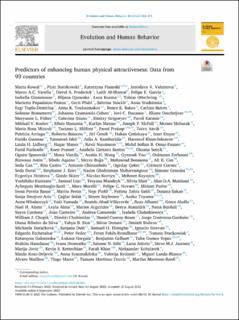Predictors of enhancing human physical attractiveness: Data from 93 countries
| dc.contributor.author | Kowal, Marta | |
| dc.contributor.author | Sorokowski, Piotr | |
| dc.contributor.author | Pisanski, Katarzyna | |
| dc.contributor.author | Valentova, Jaroslava Varella | |
| dc.contributor.author | Varella, Marco A. C. | |
| dc.contributor.author | Frederick, David A. | |
| dc.contributor.author | Al-Shawaf, Laith | |
| dc.contributor.author | García, Felipe E. | |
| dc.contributor.author | Giammusso, Isabella | |
| dc.contributor.author | Gjoneska, Biljana | |
| dc.contributor.author | Kozma, Luca | |
| dc.contributor.author | Otterbring, Anders Emil Tobias | |
| dc.contributor.author | Papadatou-Pastou, Marietta | |
| dc.contributor.author | Pfuhl, Gerit | |
| dc.contributor.author | Stöckli, Sabrina | |
| dc.contributor.author | Studzinska, Anna | |
| dc.contributor.author | Toplu-Demirtas, Ezgi | |
| dc.contributor.author | Touloumakos, Anna K. | |
| dc.contributor.author | Bakos, Bence E. | |
| dc.contributor.author | Batres, Carlota | |
| dc.contributor.author | Bonneterre, Solenne | |
| dc.contributor.author | Czamanski-Cohen, Johanna | |
| dc.contributor.author | Dacanay, Jovi C. | |
| dc.contributor.author | Deschrijver, Eliane | |
| dc.contributor.author | Fisher, Maryanne L. | |
| dc.contributor.author | Grano, Caterina | |
| dc.contributor.author | Grigoryev, Dmitry | |
| dc.contributor.author | Kačmár, Pavol | |
| dc.contributor.author | Kozlov, Mikhail V. | |
| dc.contributor.author | Manunta, Efisio | |
| dc.contributor.author | Massar, Karlijn | |
| dc.contributor.author | McFall, Joseph P. | |
| dc.contributor.author | Mebarak, Moises | |
| dc.contributor.author | Miccoli, Maria Rosa | |
| dc.contributor.author | Milfont, Taciano L. | |
| dc.contributor.author | Prokop, Pavol | |
| dc.contributor.author | Aavik, Toivo | |
| dc.contributor.author | Arriaga, Patricia | |
| dc.contributor.author | Baiocco, Roberto | |
| dc.contributor.author | Cenek, Jiri | |
| dc.contributor.author | Cetinkaya, Hakan | |
| dc.contributor.author | Duyar, Izzet | |
| dc.contributor.author | Guemaz, Farida | |
| dc.contributor.author | Ishii, Tatsunori | |
| dc.contributor.author | Kamburidis, Julia A. | |
| dc.contributor.author | Khun-Inkeeree, Hareesol | |
| dc.contributor.author | Grassini, Simone | |
| dc.contributor.author | Nyhus, Ellen K. | |
| dc.contributor.author | Siepelmeyer, Henrik | |
| dc.contributor.author | Singh, Sangeeta | |
| dc.date.accessioned | 2022-11-10T10:20:11Z | |
| dc.date.available | 2022-11-10T10:20:11Z | |
| dc.date.created | 2022-09-22T08:49:10Z | |
| dc.date.issued | 2022 | |
| dc.identifier.issn | 1090-5138 | |
| dc.identifier.uri | https://hdl.handle.net/11250/3031111 | |
| dc.description.abstract | People across the world and throughout history have gone to great lengths to enhance their physical appearance. Evolutionary psychologists and ethologists have largely attempted to explain this phenomenon via mating preferences and strategies. Here, we test one of the most popular evolutionary hypotheses for beauty-enhancing behaviors, drawn from mating market and parasite stress perspectives, in a large cross-cultural sample. We also test hypotheses drawn from other influential and non-mutually exclusive theoretical frameworks, from biosocial role theory to a cultural media perspective. Survey data from 93,158 human participants across 93 countries provide evidence that behaviors such as applying makeup or using other cosmetics, hair grooming, clothing style, caring for body hygiene, and exercising or following a specific diet for the specific purpose of improving ones physical attractiveness, are universal. Indeed, 99% of participants reported spending >10 min a day performing beauty-enhancing behaviors. The results largely support evolutionary hypotheses: more time was spent enhancing beauty by women (almost 4 h a day, on average) than by men (3.6 h a day), by the youngest participants (and contrary to predictions, also the oldest), by those with a relatively more severe history of infectious diseases, and by participants currently dating compared to those in established relationships. The strongest predictor of attractiveness-enhancing behaviors was social media usage. Other predictors, in order of effect size, included adhering to traditional gender roles, residing in countries with less gender equality, considering oneself as highly attractive or, conversely, highly unattractive, TV watching time, higher socioeconomic status, right-wing political beliefs, a lower level of education, and personal individualistic attitudes. This study provides novel insight into universal beauty-enhancing behaviors by unifying evolutionary theory with several other complementary perspectives. | en_US |
| dc.language.iso | eng | en_US |
| dc.publisher | Elsevier | en_US |
| dc.rights | Navngivelse 4.0 Internasjonal | * |
| dc.rights.uri | http://creativecommons.org/licenses/by/4.0/deed.no | * |
| dc.title | Predictors of enhancing human physical attractiveness: Data from 93 countries | en_US |
| dc.title.alternative | Predictors of enhancing human physical attractiveness: Data from 93 countries | en_US |
| dc.type | Peer reviewed | en_US |
| dc.type | Journal article | en_US |
| dc.description.version | publishedVersion | en_US |
| dc.source.journal | Evolution and human behavior | en_US |
| dc.identifier.doi | 10.1016/j.evolhumbehav.2022.08.003 | |
| dc.identifier.cristin | 2054161 | |
| cristin.ispublished | true | |
| cristin.fulltext | original | |
| cristin.qualitycode | 2 |
Tilhørende fil(er)
Denne innførselen finnes i følgende samling(er)
-
Institutt for psykologi [2886]
-
Publikasjoner fra CRIStin - NTNU [37221]

